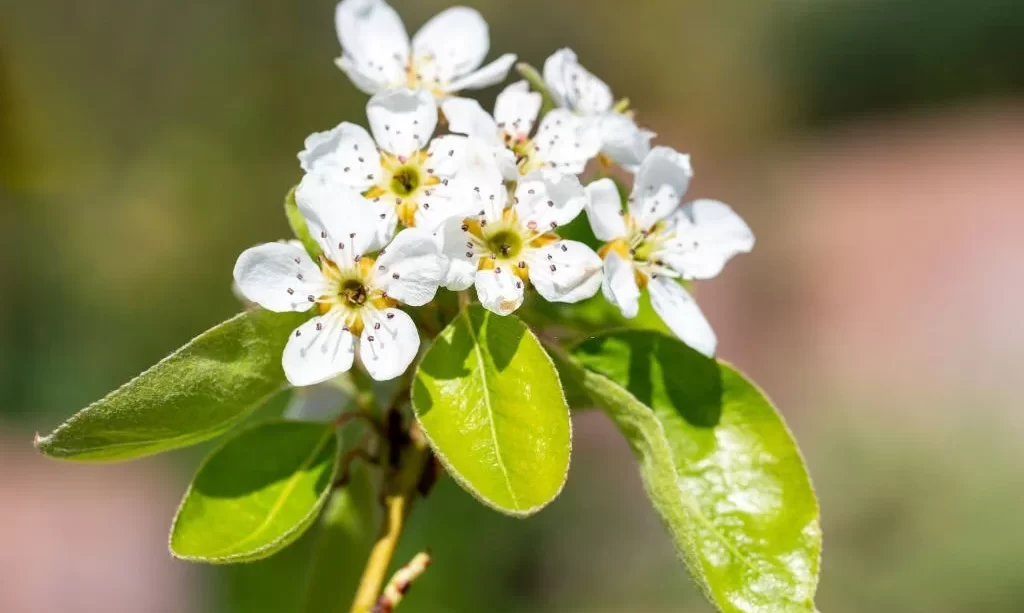Pear trees, with their delectably sweet and juicy fruits, hold a special place in orchards and home gardens. Whether enjoyed fresh, canned, or baked into pies and tarts, pears are a delightful addition to our culinary world. However, the journey from delicate pear blossoms to plump and flavorful fruits is intricately tied to the fascinating process of pollination. In this exploration, we delve into the world of pear tree pollination, specifically addressing a critical question: do pear trees self-pollinate?
- ESTABLISHED TREES FOR PLANTING — Fully Grafted & Rooted for Fruit Year 2 or 3
- COLD HARDY — Perfect for USDA Zones 5-9 & Withstands Cold Winter Temperatures
- GROW YOUR OWN FRUIT — Save Money on Grocery Bills & Eat Fresh, Organics Pear Fruit
- HYBRID ORIENTAL VARIETY — Sweet, Juicy Pears Have Creamy White Flesh & Green Skin
- FAMILY OWNED NURSERY — Grown in Florida & Shipped Nationwide
The Role of Pollination in Pear Tree Fruit Production
To appreciate the significance of pollination in pear tree fruit production, one must understand the fundamental role it plays:
Pollination is the pivotal moment when the male reproductive structures of a pear flower, the stamens, release pollen, which then lands on the female reproductive structure, the stigma. This interaction initiates a cascade of biological events leading to the formation of pear fruits. In essence, without the transfer of pollen, the beautiful blossoms that grace pear trees would never transform into the sweet and succulent fruits we relish.
One might wonder how this pollen transfer occurs. Nature has a remarkable solution in the form of pollinators. Bees, among other insects, play an indispensable role in the pear tree pollination process. As they visit pear blossoms in search of nectar, they inadvertently pick up and transport pollen from one flower to another. This unintentional act of the bees, while foraging for their own sustenance, is the key to pear tree pollination.
In essence, pollinators act as nature’s messengers, ensuring that the male and female parts of pear blossoms connect, ultimately leading to the development of fruit. The partnership between pear trees and pollinators is not only vital for pear production but also essential for biodiversity and ecosystem health.
With this understanding of the pivotal role that pollination plays in the pear tree’s journey to fruit-bearing, we venture further into the intriguing question of self-pollination in pear trees, exploring whether these trees are capable of fertilizing themselves to produce an abundant harvest.
Types of Pear Trees
To comprehend the intricacies of pollination in pear trees, it’s essential to recognize the different types of pear trees and their unique characteristics:
- European Pears (Pyrus communis): European pear trees are among the most common pear varieties cultivated globally. These include well-known varieties like Bartlett and Anjou. European pears are known for their sweet and juicy fruits with a classic pear shape. They typically require cross-pollination, meaning they need pollen from a different pear tree variety to set fruit effectively. Self-pollination is limited in most European pear trees.
- Asian Pears (Pyrus pyrifolia): Asian pear trees, also called Nashi pears or apple pears, produce fruits that are crisp and have a flavor reminiscent of both pears and apples. Unlike many European pears, some Asian pear varieties exhibit a degree of self-pollination, although cross-pollination often results in better fruit production.
- Hybrid Pears: Some pear trees are hybrids of European and Asian pear varieties. These hybrids may have varying self-pollination capacities depending on their genetic makeup.
- 8 Bartlett Pear Tree Cuttings, 6 Inc to 7 Inc Tall, Sweet Fruit Tree, No Root
Self-Pollination in Pear Trees
The concept of self-pollination in pear trees raises intriguing questions about whether a single pear tree can fertilize itself to produce fruit:
- Limited Self-Pollination: While some Asian pear varieties possess a degree of self-pollination capacity, this ability is generally limited. Self-pollination occurs when the pollen from a pear tree’s stamens successfully reaches its own stigma within the same flower or another flower on the same tree. However, even among Asian pears, cross-pollination with a different tree often leads to more reliable and abundant fruit production.
- European Pears and Cross-Pollination: European pear varieties, such as Bartlett and Anjou, typically require cross-pollination. This means that they need another pear tree of a different variety nearby to provide compatible pollen. The cross-pollination process is facilitated by pollinators like bees, which transport pollen from one tree to another, enhancing fruit set.
- Optimal Conditions for Pollination: Successful pollination in pear trees depends on various factors, including the presence of compatible varieties within close proximity, the activity of pollinators, and favorable weather conditions during flowering. These factors collectively influence the quantity and quality of pear fruit production.
In summary, self-pollination in pear trees, while present to some extent in certain Asian pear varieties, is generally limited. Most pear trees, especially European pear varieties, benefit from cross-pollination with other pear trees to ensure optimal fruit set and a bountiful harvest. Understanding the pollination requirements of specific pear tree varieties is essential for orchard planning and maximizing fruit production.
Cross-Pollination in Pear Trees
Cross-pollination is a central aspect of pear tree pollination, where the transfer of pollen occurs between two different pear tree varieties. This process is particularly crucial for European pear varieties, such as Bartlett, which often rely on compatible pollinizer trees to ensure successful fruit production:
- Pollinizer Varieties: In pear tree orchards, pollinizer varieties are carefully selected to complement the primary fruit-bearing varieties. These pollinizers release pollen that is compatible with the female flowers of the main pear tree varieties, facilitating the pollination process.
- Varietal Compatibility: It’s essential to choose pear tree varieties for cross-pollination that are compatible in terms of flowering times and pollen compatibility. Some varieties may not effectively cross-pollinate due to differences in bloom periods or genetic factors.
- The Role of Pollinators: While specific pear tree varieties may bloom concurrently, ensuring cross-pollination, the assistance of pollinators like bees remains crucial. Pollinators facilitate the transfer of pollen between trees, improving the likelihood of successful pollination and fruit development.
- Improved Fruit Set: Cross-pollination enhances the fruit set in pear trees, resulting in larger and more abundant harvests. The exchange of genetic material between different pear varieties can also lead to improved fruit quality.
Pollination Challenges and Solutions
Despite the importance of cross-pollination, several challenges may arise in pear tree pollination, including:
- Limited Pollinator Activity: If pollinator populations are scarce or if adverse weather conditions hinder their activity during the flowering period, it can impact pollination success. Planting pollinator-friendly plants in the vicinity can attract and support these vital insects.
- Inadequate Cross-Pollination Partners: In some cases, there may be a lack of compatible pear tree varieties nearby, leading to suboptimal cross-pollination opportunities. Orchards can address this issue by diversifying pear tree selections or grafting compatible branches onto existing trees.
- Weather-Related Challenges: Unpredictable weather patterns, including late frosts or heavy rains during flowering, can disrupt pollination efforts. Orchards may employ protective measures such as frost cloth to mitigate these risks.
- Monitoring and Management: Regular monitoring of pear tree orchards during the flowering period is essential to assess pollination progress. Orchard managers can take proactive measures to address pollination challenges and optimize fruit set.
- 🌳 All pictures are of fully grown plants. Sizes shipped are in the title and description. Deciduous plants do not have leaves in the winter!
- 🚫 CALIFORNIA ORDERS WILL BE SHIPPED BARE ROOT!
- ☀️ Zone: 4-9 / Mature Height: 20′ Spread: 20′ / Growth Rate: fast / Full Sun
- 🪴 Size shipped: 2-3 ft tall shipped bare root and double boxed for safe transport.
- 🍐 These pear trees are self-pollinating. However, planting 2 or more will significantly increase your fruit yield.
Conclusion
In the world of pear trees and their enchanting blossoms, the question of self-pollination is a nuanced one. While certain Asian pear varieties possess some capacity for self-pollination, the majority of pear trees, especially European pear varieties, benefit significantly from cross-pollination with other compatible varieties.
Understanding the specific pollination requirements of pear tree varieties is essential for successful fruit production. Cross-pollination, facilitated by pollinizer varieties and assisted by pollinators like bees, is the key to ensuring optimal fruit set and the development of abundant, flavorful pears.
As orchard managers and home gardeners alike navigate the complexities of pear tree pollination, they can harness the beauty of blossoms and the collaboration of nature’s messengers – pollinators – to yield the delicious fruits that grace our tables. In doing so, we not only celebrate the bounty of the pear tree but also contribute to the vitality of ecosystems through the essential act of pollination.







